This week on The Hacklet we’re featuring some of the best keyboard hacks from Hackaday.io!
Hackers are really into their keyboards. Everyone has a favorite, and those favorites vary wildly. Mechanical, soft touch, ergonomic, QWERTY, DVORAK, chorded, you name it, there is a hacker, maker, or engineer who loves it, or absolutely hates it. For some, no commercial product is perfect. All is not lost though, as a custom keyboard is just a hack away!
[Warren Janssens] gets things rolling with Ergo60, his 60 key ergonomic keyboard. [Warren’s] layout is a pair of 25 key hand clusters, each with a matching 5 key thumb cluster. This layout minimizes lateral wrist movement. With the reduced key count and stacked keys, the user’s hands never move from the home row. [Warren] rolled his own PCBs for Ergo60. A Teensy 2.0 running a fork of TMK serves as Ergo60’s controller. [Warren’s] is running Cherry Black switches and his keycaps are from Signature Plastics. [Warren] is using Ergo60 as his daily driver these days, so it’s no surprise that he’s set the “Completed Project” tag.
Some say he needs no keyboard at all, and that his heartbeat sounds just like an IBM Model M. All we know is he’s called [Brian Benchoff]. [Brian’s] created a pair of minimalist keyboard projects. The Unhappy Hacking Keyboard takes us back to basics. After all, computers run on 1’s and 0’s, right? What more could a person need? Apparently just a space and return. Unhappy Hacking Keyboard uses an ATtiny85 with V-USB as the controller and the interface. Keys are cherry MX blues. The keycaps are [Brian’s] own Hackaday Cherry MX Keycaps printed by Shapeways.
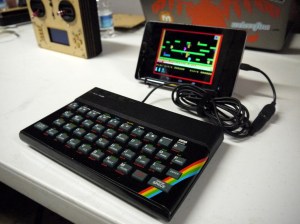 An entire generation of hackers don’t know the joy of typing on a tiny rubber keyboard. [Alistair MacDonald] aimed to fix that, so he turned an old computer into a keyboard with his ZX Keyboard. [Alistair] started with a broken ZX Spectrum. He gutted the original electronics and added an Ardunio Pro Mini running the V-USB library. [Alistair] directly wired the row and column I/O lines from the keyboard to his Arduino. The result is a keyboard which is the perfect size for cell phones, Raspberry Pi’s and the like.
An entire generation of hackers don’t know the joy of typing on a tiny rubber keyboard. [Alistair MacDonald] aimed to fix that, so he turned an old computer into a keyboard with his ZX Keyboard. [Alistair] started with a broken ZX Spectrum. He gutted the original electronics and added an Ardunio Pro Mini running the V-USB library. [Alistair] directly wired the row and column I/O lines from the keyboard to his Arduino. The result is a keyboard which is the perfect size for cell phones, Raspberry Pi’s and the like.
 [Servo] teaches us new ways to type with Chordy KEY, his chording keyboard project. Chordy Key is meant to be used in the left hand. Five finger buttons and three thumb buttons are all that is needed to chord out 64 different letters and symbols. [Servo] utilized an ATmega32U4 powered Sparkfun pro micro to control his keyboard. Chordy Key is a proof of concept, but with [Servos’s] use of 3D printed parts, Chordy Key looks like it’s ready for your next wearable computing project!
[Servo] teaches us new ways to type with Chordy KEY, his chording keyboard project. Chordy Key is meant to be used in the left hand. Five finger buttons and three thumb buttons are all that is needed to chord out 64 different letters and symbols. [Servo] utilized an ATmega32U4 powered Sparkfun pro micro to control his keyboard. Chordy Key is a proof of concept, but with [Servos’s] use of 3D printed parts, Chordy Key looks like it’s ready for your next wearable computing project!
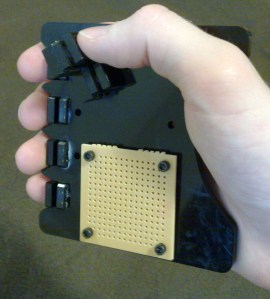 [jmptable] is also working on a chorded keyboard design. Chord Keyboard uses only 7 keys to send the entire ASCII character set and a few control combinations. [jmptable] used an ATmega328P as his processor. Chord keyboard isn’t wired though. An RN-42-HID module provides bluetooth connectivity to the world.
[jmptable] is also working on a chorded keyboard design. Chord Keyboard uses only 7 keys to send the entire ASCII character set and a few control combinations. [jmptable] used an ATmega328P as his processor. Chord keyboard isn’t wired though. An RN-42-HID module provides bluetooth connectivity to the world.
[jmptable] has provided an amazing amount of detail on his research, including one of his goals of adding a chorded keyboard to the Gameboy Advance. They keyboard itself would be mounted on the spine of a game cartridge. We would love to see that idea come to fruition, [Servo]!
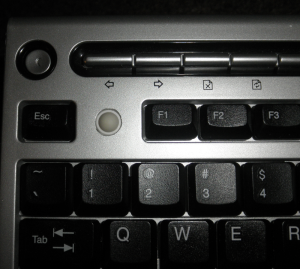 Finally we have [Gertlex], who just wanted a scroll wheel embedded in his keyboard. He got there with the help of an Apple Mighty Mouse. Keyboard with Apple Mouse Scroll Ball is one of those hacks that looks like it original equipment. [Gertlex] took a drill to a Targus slim USB keyboard, putting a small hole right between the ESC and F1 keys. He fit the scroll ball from his Apple Mighty Mouse in the hole. Electronics are as simple as plugging the mouse and keyboard into the same USB hub. The only downside to the design is that [Gertlex’s] keyboard doesn’t recognize fast enough to send key presses during the boot process.
Finally we have [Gertlex], who just wanted a scroll wheel embedded in his keyboard. He got there with the help of an Apple Mighty Mouse. Keyboard with Apple Mouse Scroll Ball is one of those hacks that looks like it original equipment. [Gertlex] took a drill to a Targus slim USB keyboard, putting a small hole right between the ESC and F1 keys. He fit the scroll ball from his Apple Mighty Mouse in the hole. Electronics are as simple as plugging the mouse and keyboard into the same USB hub. The only downside to the design is that [Gertlex’s] keyboard doesn’t recognize fast enough to send key presses during the boot process.
That’s just about enough keystrokes for this episode of The Hacklet. As always, see you next week. Same hack time, same hack channel, bringing you the best of Hackaday.io!
Update – check our our keyboard list right here!


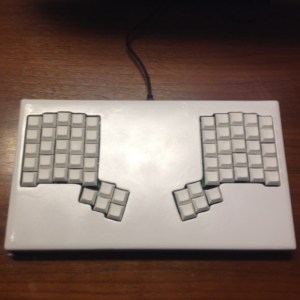
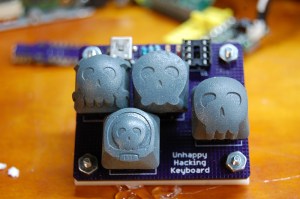















I feel obliged to mention keyboard.io
And im glad you did
For Android there is dimple.io – NFC button stickers to put on the phone and link to some action. Video here http://youtu.be/Fdx9J4hElqs?t=21s . I’d love something similar but for Windows. There are many great keyboard out that that only need a little tweak here and there. Sticking on some small buttons would be perfect. Could be BT4 connected rather than NFC. Has anyone seen anything like that for sale?
i’d kill for a phone with physical keys for the back/home/apps fake buttons.
this keeps getting worse every android generation.
started with normal buttons. perfect.
then they become those extremely bright only-works-when-you-press-right buttons. meh. at least they don’t move around
now they are wasting screen space, and everytime you watch a movie in landscape and they hide as little dots, you have no idea where to touch because they keep moving!
next android gen, they will probably dance around the screen.
i’d say apple does this right if they had any light whatsoever on their fixed button. but they don’t. HP almost got it right, but made the ligh pulse for some reason on the palm devices.
Is [Brian Benchoff] the hackaday ‘Stig’? Perhaps he should always be introduced in the Top Gear style!
No, but only because I’m not three different guys.
I want to understand this but not enough to want to watch even the introduction of ‘Top Gear’
Little tiny rubber keys would have been a blessing on my first computer- a Timex Sinclair 1000 with a gawdawful membrane keyboard. Seeing the Spectrum hack I may try to give my old TS1000 a new life. There’s probably enough room under the hood to install a Raspberry Pi.
Attempting to put a REAL keyboard on my TS-1000 killed it. (sniff!)
Nice work Brian, but I have to wonder that if you wire it right, would you be able to turn your “keyboard” into one that could use Morse code instead? As in, it just has a single key and you use the Morse code equivalent of a full stop as a carriage return.
How would I change the “click” on the mouse wheel to a carriage return?
X-Mouse Button Control from http://www.highrez.co.uk . Lets you define any mouse button to any click or keyboard function. I’ve set the 2 otherwise-useless side-buttons on my mouse to work the computer’s volume control. But you can set any button to anything, per-program if you like, and have “sheets” or “pages” of options you can flip through. Using a mouse button.
It’s great. Sort of thing you might hack up in Unix, except it’s for Windows. And, of course, free. What a decent chap the author is.
The ‘Chord keyboard’ might be good in mobile/wearable computing environments.
Before “wearable” computing was manufactured, a lot of people put embedded computers (like pc104s) in backpacks and threw LCDs on their forearms, this was the primary input method since you could still walk around while typing.
Ahhh, PC104! And that Canadian “cyborg” fella with the video-camera viewfinder attached to one eye! Cos that’s all the primitive cyborgs had, children!
The Agenda Microwriter was quite popular in the UK at least back around 1990. A 32K text-editor pocket-size device, with a few organiser functions. It had a tiny alphabetic keyboard, and 5 chorded keys arranged in the shape of a hand. Users could get pretty fast, taking notes on the move. Obviously came with a serial connection for your computer of choice. People swore by them (and not at them!).
Not hackaday.io, but purely awesome project: recreating the Datahand from scratch http://geekhack.org/index.php?topic=41422.0
Not hackaday, but purely awesome project: recreating the datahand http://geekhack.org/index.php?topic=41422.0
The Datahand is one of the most ergonomic keyed (?) keyboards ever. Anyone know of a non-keyed letter/word input (eg, not from physical switches), popular mobile OS input not withstanding (eg, Swype style)? 8pen was fun, but doesn’t translate well to the desk top and after years of using it, I was still slow.
Have you tried Dasher? https://en.wikipedia.org/wiki/Dasher_(software)